5th November 2019
The image below shows the levels of dust particles in the atmosphere in January 2019. While Europe and the US rarely experience the sort of levels that are currently making headlines in India, we shouldn’t be complacent.
By the time smog becomes visible, air quality can already be at unhealthy (100+) levels. So how can we know just how much of these toxic dust particles are floating all around us?
The Kaiterra Laser Egg
The Laser Egg is an updated version of Kaiterra’s original AQI monitor of the same name that launched in 2015. This new 2019 version adds indoor temperature and humidity monitoring to the AQI and PM2.5 particle detection of the previous model.
The Laser Egg’s accuracy has tested very favorably among other consumer level air quality monitors.
Design
The unit is attractive and certainly beats most of the cheaper models when it comes to styling. There’s a 6.5cm (2.6″) screen at the front, a power and mode button on top and micro USB charging port at the rear which powers the monitor. The box also contains a small printed manual in English and Chinese, and a USB charging cable.
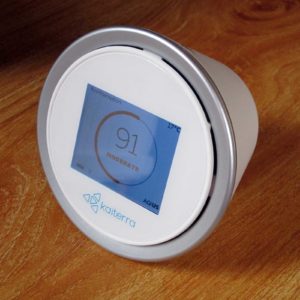
An internal fan draws air in at the rear, across the sensor then exhausts it out the front. Although quiet, there is a faint buzz / whine from time to time which is really only noticeable at night or in a very quiet room.
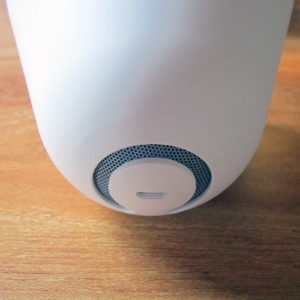
There are just two buttons on the unit; power and mode. Press and hold the power button for a second or two to start-up / shutdown, while the mode button cycles through the 5 display modes.
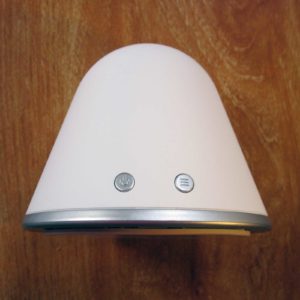
Display
The screen is a little disappointing at this price point and it lets the rest of the unit down somewhat. The brightness is fine and can be adjusted via the app, but by modern standards the resolution is low with a poor viewing angle.
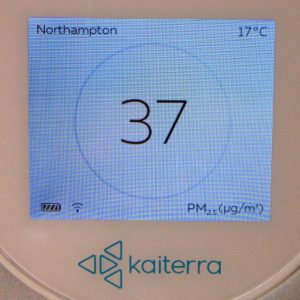
The unit has five display modes that cycle through by pressing the mode button…

The 5th mode is “LCD off” and dims the screen to its minimum setting. This is still just about visible at night but it’s low enough not to interfere with sleep.
Wi-Fi
The Laser Egg will only connect to 2.4GHz WiFi networks, not 5GHz, which is very disappointing in this day and age.
The Kaiterra smartphone app for iOS or Android is needed to connect the Laser Egg to a Wi-Fi network.
After installing the app on to your smartphone, make sure your phone is connected to your Wi-Fi network then press and hold the “mode” button on the LaserEgg to generate a pairing QR code on screen.
In the app select “Add device” and scan the QR code. This will send the Wi-Fi name (SSID) and password of whichever network your phone is on to the LaserEgg.
With a bit of luck this will add the monitor into the app and also allow it to access the internet where it can upload its records. This historical data can be viewed and also exported as a .CSV file by creating an account at https://dashboard.kaiterra.com
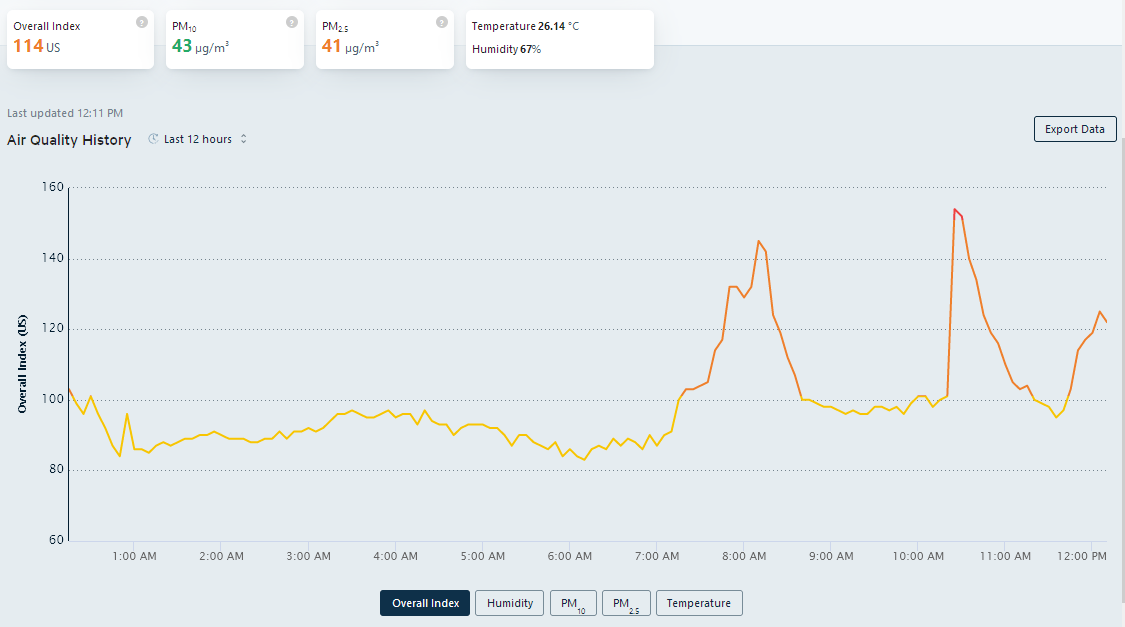
The app also adds extra functionality to the monitor including local outdoor air quality and weather information, plus automatic checks for any firmware updates…
| Without App | With App | |
|---|---|---|
| PM2.5 Readings | ✓ | ✓ |
| Temperature Readings | ✓ | ✓ |
| Humidity Readings | ✓ | ✓ |
| Weather Forecast | ✗ | ✓ |
| Pollution Alerts | ✗ | ✓ |
| Automatic Calibration | ✗ | ✓ |
| Firmware Updates | ✗ | ✓ |
Kaiterra “Live Air” App
As of February 2023 the Kaiterra data upload and cloud storage has been non-functional the majority of the time.
As can be seen below, despite being online 24 hours a day the data from my monitor was only recorded for a few hours at a time before going offline, sometimes for several days. This affects both the cloud dashboard and the Live Air app.
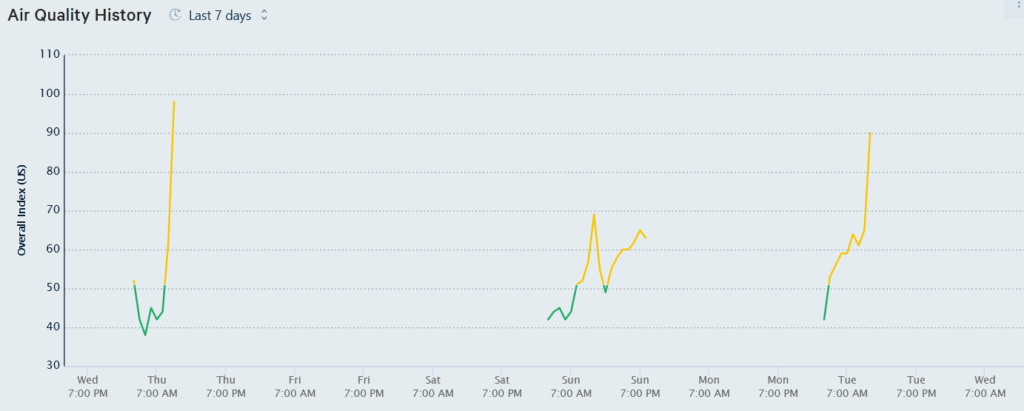
The monitors cloud dashboard also regularly shows the unit as “offline” despite the device itself being connected via Wi-Fi and successfully receiving local weather updates from the internet.
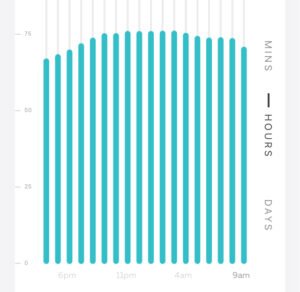
With regard to the app, there are a couple of areas where it could be improved. Some of the text in the app is so low in contrast (light grey text on a white background) that it’s almost impossible to read even at maximum screen brightness.
Secondly, as a recommendation, it would be nice if the “current” and historic particulate information for locations around the world could also include information on future predicted levels over maybe the next 24 hours.
Websites like https://aqicn.org are able to forecast levels in advance so maybe Kaiterra could offer this in future updates?
Conclusion
| Pros | Cons |
|---|---|
| ✓ Attractive design | ✗ Relatively expensive |
| ✓ Good feature set | ✗ Screen quality |
| ✗ Doesn’t work on 5GHz Wi-Fi | |
| ✗ Data upload to online database unreliable | |
| ✗ Product now discontinued |
Update August 2022
Kaiterra have announced they are discontinuing the Laser Egg range. Due to this development and the aforementioned niggles, GroupTestWinner no longer recommends purchasing any of the Kaiterra Laser Egg range.
They will still be available for sale until stock runs out and Kaiterra say existing customers can “continue to use the products,” which is nice of them but “no further updates or upgrades will be available going forward” – support.kaiterra.com/laser-egg-discontinued.
New purchases will still have a 1 year warranty but there will be no option to extend this going forward.
This also means no further upgrades to the Live Air app, which had already gone over a year since the last update.
Original Verdict (2019)
The Laser Egg used to come recommended. As well as measuring indoor air quality it also kept you updated on readings from your nearest air quality measuring station via the internet.
Although the screen quality is disappointing considering the price point, the unit still looks modern and stylish. The lack of support for 5GHz WiFi networks is a serious omission however, as dated 2.4GHz is being fazed out in favour of 802.11ac networks.
One other slight niggle is that it only comes with a USB cable for power so needs to be situated quite close to a USB power source. It would have been nice to have a longer cable included with the option to be plugged in permanently at a wall socket.
Verdict (updated February 2023)
Can no longer be recommended. While the positive comments above about the actual unit still apply, the fact that the product has been discontinued and that the online functionality now only works about 10% of the time makes the whole product feel neglected.




